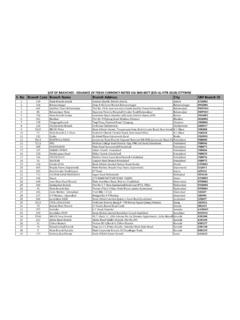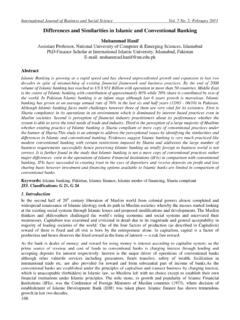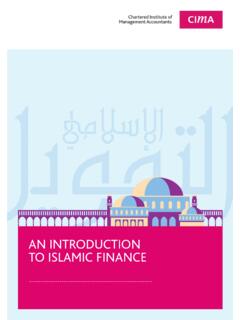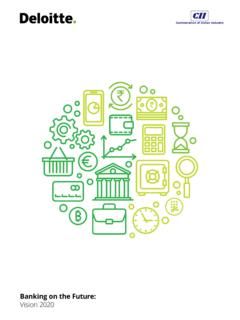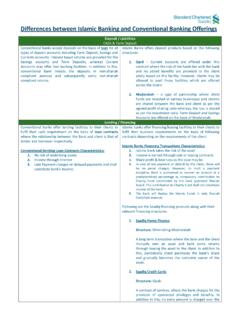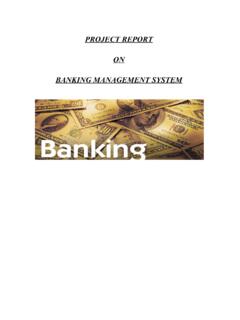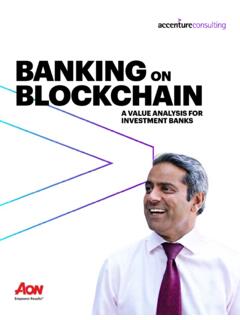Transcription of BASIC DIFFERENCES BETWEEN CONVENTIONAL AND …
1 BASIC DIFFERENCES BETWEEN CONVENTIONAL AND ISLAMIC BANKINGM odes of Finance: CONVENTIONAL BankingConventional banks only have onemodeof financing for its customers and that is Loan .Be it an individual customer, a business partnership or a corporate client. They all can avail an array of products with an underlying mode of debt only from a CONVENTIONAL bank. However, CONVENTIONAL banks have designed several products such as credit cards, running finance, car/house loans and long-term loan facility for different customer segments but all of them simplify to a loan advanced by a bank to its instance, a credit card is also a debt instrument, also a car lease finance translates into an accrued loan for any , a registered partnership/ corporate customer avails both short-term and long-term financing facilities.
2 All of them are essentially outstanding loans to a company and they pay interest/mark-up to the bank on quarterly/annual example, if a customer avails a house/car finance from a bank and due to some reason car/house gets destroyed (total loss). The bank would then ask the customer to keep paying monthly installments despite the asset loss till insurance settlement comes in or else the customer would be reported defaulter in case of non-payment of the same and their e-CIB shall also be adversely affectedIslamic BankingIslamic banks primarily work upon three modes of finance, namely, rental arrangement (Ijarah), trade/ sale basis (Murabaha, Musawammah, Salam, Istisna& Tijarah) and partnerships (Mudarabah& Musharakah).
3 Rental Basis (Ijarah): -Ijarah or rental arrangement is where the usufruct of a durable asset is leased out to a customer against a certain rental payment for a mutually agreed Sale Basis: Murabaha: -It is that sale where bank (seller) discloses the cost and profit to the customer (buyer).Musawammah: -It is an ordinary sale where bank (seller) does not disclose cost and profit to its customer (buyer).Salam: -It is a sale where 100% payment is made in advance and goods delivery is set on a future date. Also, it has a limitation to be done upon homogenous : -Sale transaction with spot or part payment for manufactured goods. An order is placed with the manufacturer to make a specific commodity to the purchaser.
4 Tijarah: -It is a sale and agency based financing facility where finished stock is sold by customer (seller) to bank (buyer) to generate working capital for further business DIFFERENCES BETWEEN CONVENTIONAL AND ISLAMIC BANKINGM odes of Finance: CONVENTIONAL BankingBanks may offer this facility to manufacturer/producer/trader who sell finished goods on credit Modes:Musharkah: -Musharakahis a partnership where all the partners invest capital in a joint business and become owners of the business with their ratio of investmentThey share profits as per agreed profit sharing ration and share loss as per investment : -Mudarabahis a partnership where one party invests capital (Rab Ul Maal) and the other party renders services (Mudarib) in a joint banks operate all types of savings/ remunerative accounts and term deposits on Mudarabahbasis.
5 Islamic banks invest customer s deposits in Shariah-compliant avenues and share the profits with customers as per profit sharing ratios agreed on monthly basis. Other banking Modes:Kafalah: -It refers to the guarantee an Islamic bank provides to a third party (probably another bank or company)on behalf of its customer, in case they fail to pay the third party in due : -It is usually a paid agency contract, where a customer hires a particular service from an Islamic bank for a certain Name/ Type/ (Underlying Mode)Islamic (Underlying Mode)DifferenceLIABILITY SIDE:Current A/C All types & variants for Businesses/ IndividualsLoan Based Qard(Loan) BasedIslamic Current Account are Qardbased and funds are invested in shariah compliant avenues.
6 However in CONVENTIONAL banking , customer s deposited funds are used in money lending and interest earning businesses. Savings A/C & Term Deposits -Businesses/ IndividualsInterest BasedMudarabahbasedSavings Account in CONVENTIONAL banks are based on loan/qardbasis and CONVENTIONAL banks pay interest earned on loans to its depositors as returns whereas in Islamic banks saving account are based on the concept of Mudarabahand Islamic banks pay out actually earned profits on shariah compliant a partnership of services and capital BETWEEN two parties. In Islamic banks, banks render their services/ expertise against a capital (deposit) of a customer. It is a partnership where the returns are shared BETWEEN the bank and client as per the agreed profit sharing ratio whereas, the loss is borne by the investor.
7 Interest rate/ profit rateConventional banks pay a fixed rate of return on depositor s principle amount kept with the , Islamic bank pays a proportion of actual profit earned and realized to its depositors as per weightages and profit sharing SIDE:Running Finance/Working Capital LimitsLoan/revolving credit facilityAlfalah Running Musharkah/Alfalah Salam/ Alfalah Istisna/ Falah TijarahFinance/ Alfalah Murabaha Finance(Underlying mode is chosen as deemed suitable for a certain customer)The risk of CONVENTIONAL and Islamic bank varies significantly. CONVENTIONAL banks only risk is if customer defaults and does not pay back the loan along the interest bank s risk changes with the mode of financing, each mode has a different risk profile, and customer s business nature also adds in Islamic bank s risk of financing.
8 For example, in trade modes like Murabaha/ Musawammah, Islamic bank actually owns the very asset(s) in the transaction and assumes all associated risks of the asset(s) before selling them to the customer. If asset(s) go into total loss during the process of sale to customer, Islamic bank would solely bare the GuaranteesCredit warranty against a Fee(as per SOC) & mark-up on credit advancedTrade based modes:Murabaha/Musawamah(As explained above)Service based modes:Wakala/ Kafalah(As explained above)Both Islamic and CONVENTIONAL banks charge a fee against these non-funded facilities, which is allowed in Shariah. However if CONVENTIONAL banks make payments on behalf of its customer, it charges interest to them on delayed payments to the bank.
9 Islamic banks cannot charge interest but they charge profit on credit sale of imported goods to the customer, as the import is made on risk of the bank in such case.(under bank s ownership)ASSETS SIDE:Long-Term FinanceA loan facility spread over years of Diminishing Musharakah/Alfalah IjarahConventional banks provide loans to their customers and charge mark-up (interest quarterly) to their customers on the outstanding principle amount. Compounding of interest also takes place on annual basis. Whereas in case of DM, Islamic banks form joint ownership in a new asset and rent out their share of asset to the customer and also sell its ownership share in that very asset to the customer on periodic basis.
10 Thus called diminishing musharakah, a declining partnership, where bank s ownership share decreases and customer s increases over the Ijarah, an asset is bought on behalf of customer and its usufruct is leased out to the customer for a certain tenor, the bank remains owner of the asset throughout the tenor and receives monthly installments from customer. However, transfer of asset is done either by gifting (Hiba) the asset to the customer at the end of tenor, or by recognizing last installment/ security deposit of the customer as consideration for the sale of asset to the DIFFERENCESL ending & Borrowing banks borrow funds from depositors on qarzand further advance money to customers on loan.
